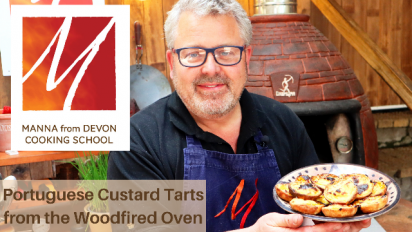Portuguese Custard Tarts from the Woodfired Oven
These Portuguese Custard Tarts are a complete joy – a classic combination of creamy custard, crispy pastry and a slightly charred top to cut through the sweetness. Much more than the sum of its parts, if you get it right, your friends and family will be clamouring for more!
Like all good combination dishes – lasagne, fish pie – there are a variety of stages along the way so plan ahead and you’ll be fine. And no, a tub of custard from the supermarket won’t work; we’ve tried it and it volcanoes its way out of the pastry cases leaving you with all base and no filling, very disappointing! Just think of the custard as another culinary string to your bow – it is in fact, creme patissiere, and with that you can create many good things just with eggs, milk, flour and sugar.
We hope you like this recipe – we really love it. We make these Portuguese custard tarts on our Woodfired Expertise course so do join us if you’d like to make them with us!
The workshop is on our youtube channel here so do check out how David cooks the tarts. He’s using our Bushman Santorini refractory oven but there are tips for using a metal oven too. Recipe below. Do let us know how you get on – we love to hear your results!
Ingredients – for 12 tarts
For the Custard
300ml milk (we usually weigh milk out as like water, one ml is one g)
3 egg yolks
50g caster sugar
25g plain flour
10g cornflour (cornstarch in the US)
1tsp vanilla extract or the seeds from one vanilla pod
For the Pastry
70g plain flour (all purpose)
Pinch of salt
1tsp ground cinnamon
50g frozen butter – make sure to freeze the butter the day before you want to use it
12 tsp tangerine conserve – or similar (optional). Or 6 tsp if you want half the tarts jammy and half plain
Oven state, equipment etc
The oven wants some good bottom heat to crisp the pastry and top heat to brown the custard. Also no active embers in a refractory oven or a bed of embers to the side in a metal oven to keep the heat up.
Heat deflector to keep the oven tidy and to prevent side scorch from any active embers
Door on for a refractory oven and no active embers; slightly ajar for a metal oven with active embers so the fumes can escape.
Temperature – about 250/275C on the floor; 200C air temperature (3-4 Mississippi)
1 x 12 jam tart tin (or 2 x 6 tart tins as we did)
Method
Custard
- Put the milk in a non-stick saucepan and gently bring to the boil. (actually our pan is a thick stainless steel one which we know will clean up well and won’t stick much especially if we keep stirring the custard!)
- As the milk is heating, mix the egg yolks, sugar and flours in a large bowl so you get a smooth yellow paste.If you are using vanilla seeds, put them in now; if you are using vanilla extract, stir it into the finished custard)
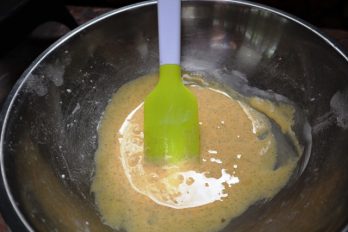
We used vanilla seeds, hence the little black dots
- When the milk is just boiling, pour it on to the eggy mixture and stir well.
- Pour this back into the pan and stirring all the time, bring to the boil over a gentle heat. The custard will become thick and lumpy but don’t panic, just keep stirring.
- When it’s boiling, you can leave it to bubble gently for a couple of minutes and then pour it into a large clean bowl. Stir in the vanilla extract now if you are using it.
- Cover the thick custard with clingfilm or waxed paper right on the surface to prevent a skin forming and leave to cool. Keep the custard in the fridge until you are ready to use it.
Pastry
- Mix the plain flour, ground cinnamon and salt in a large bowl.
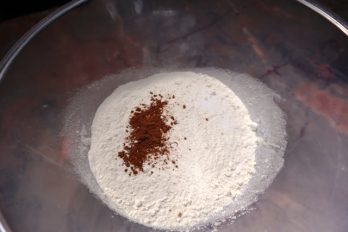
Leave out the cinnamon if you like
- Then grate the frozen butter into it, shaking regularly to cover the butter.
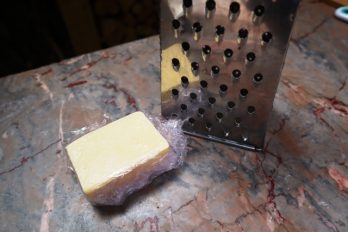
Use the thick side of the grater
- Use just enough iced water to bring the pastry together to make a dough. It will look a bit rough around the edges but don’t panic, it will sort itself out in the fridge.
- Wrap the pastry dough in clingfilm or equivalent (we use the clingfilm the butter was wrapped in) and put it in the fridge for at least 30 minutes and up to 3 hours.
- Roll out the pastry so it’s nice and thin – this will help to get your crispy pastry cases.
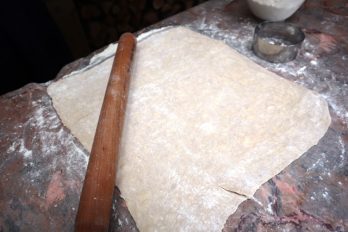
Use plenty of flour so the pastry doesn’t stick
- Cut out 12 thin circles to fit your jam tart tin.
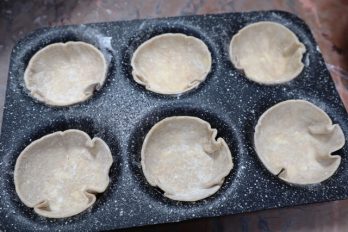
Neatly done – ish!
Tarts
- If you are using the tangerine conserve, put a teaspoon of it in the base of each pastry case.
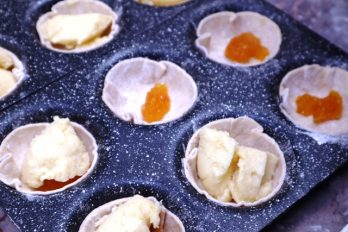
A surprise in the base!
- Then top with the cool, thick creme patissiere/custard.
- Bake in the oven for 7 mins 30 seconds and then turn the tart case around for even baking.
- Bake for the same time again and take the tarts out of the oven if they are ready; leave for a little longer if your oven isn’t as hot as ours was.
- Cool for a minute or so in the tin and then leave them to cool on a wire rack.
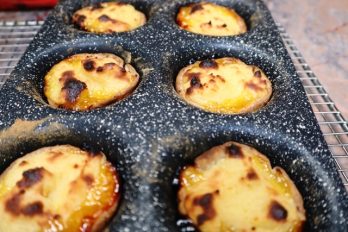
These will be super hot straight out of the oven!
- Eat while still fresh and the pastry is still crispy with a great cup of coffee.
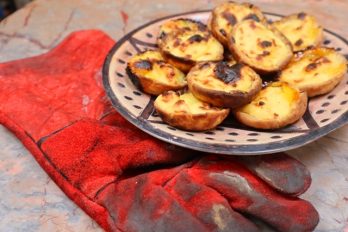
Cool before eating while still fresh
Alternatives/tips
- This amount of custard will fill 12 pastry cases. If the custard has thickened up a lot, put it in a large bowl and beat with a wooden spoon until more manageable. Don’t use a food processor for this as it aerates the custard and then it will soufflé out of the tart cases when you bake them.
- Instead of tangerine conserve, use some marmalade for a deep citrus hit.
- We’ve heard a spoonful of chocolate spread in the base is a great alternative.
- You can of course leave the conserve out and have the tarts traditionally plain.
- Leave the cinnamon out of the pastry if you don’t like it or maybe exchange for some grated nutmeg.
- You can freeze the made pastry (big thanks to Delia Smith for this revelatory pastry – we use it a lot for Tarte Tatin, empanadas, sausage rolls, mince pies)
- Any pastry trimmings can be reused – lovely for some cheese straws.


